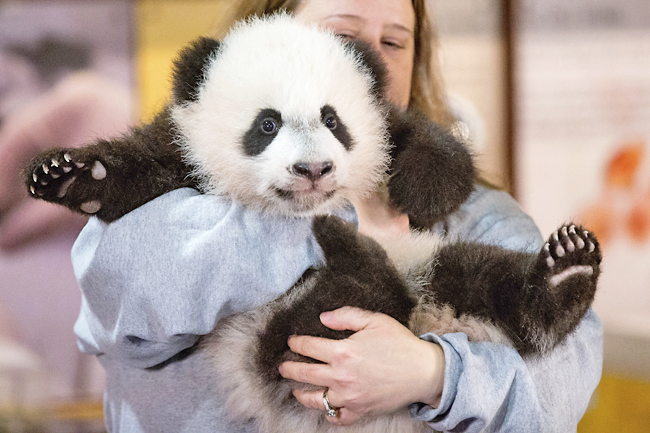WASHINGTON (AP) – China’s panda diplomacy may have one true winner: the pandas themselves.
Decades after Beijing began working with zoos in the United States (US) and Europe to protect the species, the number of giant pandas in the wild has risen to 1,900, up from about 1,100 in the 1980s, and they are no longer considered “at risk” of extinction but have been given the safer status of “vulnerable”.
Americans can take some credit for this accomplishment, because conserving the species is not purely a Chinese undertaking but a global effort where US scientists and researchers have played a critical role.
“We carry out scientific and research cooperation with San Diego Zoo and the zoo in Washington in the US, as well as European countries. They are more advanced in aspects such as veterinary medicine, genetics and vaccination, and we learn from them,” said Zhang Hemin, chief expert at the China Conservation and Research Centre for the Giant Panda in the southwestern Chinese city of Ya’an.
Zhang spoke to journalists during a recent government-organised media tour at the Ya’an Bifengxia Panda Base, home to 66 pandas that lolled about and chomped on stalks of bamboo in a tranquil setting rich with vegetation.
A pair of pandas that arrived at the San Diego Zoo in June will debut to the public after several weeks of acclimation. Another pair will reach the Smithsonian’s National Zoo later this year, and a third pair will settle in the San Francisco Zoo in the near future.
Conservation is keeping the two sides working together. Zhang said there are benefits from sending pandas overseas.




“Pandas temporarily living abroad raises humans’ awareness of preservation, and promotes attention to our planet and the protection of biodiversity,” Zhang said. “Why isn’t it good?”
Zhang said pandas sent overseas have been selected for their good genes. “They have very high hereditary values. If they bear offspring, the cubs also will have very high hereditary values,” he said.
While Western research leads in genetic studies, China excels at feeding and behavioural training, he said.
“It’s mutually complementary,” Zhang said.
The ultimate goal, researchers say, is to help the bears return to the wild and survive, and a larger captive-bred panda population is the foundation for that effort.
The first giant pandas sent abroad were gestures of goodwill.
Beijing gave a pair of pandas – Ling-Ling and Hsing-Hsing – to the US following President Richard Nixon’s historic visit to China in 1972 and then other pandas to other countries, including Japan, France, Britain and Germany, over the next decade.
When the panda population dwindled in the 1980s, Beijing stopped gifting pandas but turned to short-term leasing then longer-term collaboration with foreign zoos on research and breeding.
Under the arrangement, Mei Xiang and Tian Tian arrived at the National Zoo in 2000, with the ultimate goal of saving giant pandas in the wild. Over the 23 years Mei Xiang lived in the US capital, she gave birth to four living cubs: Tai Shan in 2005, Bao Bao in 2013, Bei Bei in 2015, and Xiao Qi Ji in 2020. All have been returned to China.
Bei Bei, sent to China in 2019, walked over to a row of lined-up bamboo shoots last month, picked one up with his teeth and sat down to eat it as a cluster of visitors looked on at the Ya’an Bifengxia Panda Base. Staff described the nearly nine-year-old male as sociable.
Smithsonian scientists have been working to “unravel the mysteries of panda biology and behaviour, gaining crucial insights into their nutritional needs, reproductive habits and genetic diversity”, the National Zoo says in its literature on the panda programme.
Its ecologists have been working with Chinese partners to restore natural habitats for the giant panda, the zoo said.
Over the years, it has raised tens of millions of dollars to run the zoo’s panda conservation programme, including an annual fee of USD1 million to the China Wildlife Conservation Association.
“The purpose of the fund is stated very clearly – it’s scientific and research funds for the preservation of wild giant pandas and their habitats,” Zhang said. “They are very clear about this. It’s not an income of the Chinese government.”
Pandas born overseas can face a language barrier when they are sent to China, said Li Xiaoyan, the keeper for Bei Bei and two other bears from abroad.
“Some pandas may adapt very quickly and easily upon return, while others need a long time to adjust to a new environment, especially human factors such as language,” Li said.
“Overseas, foreign languages are spoken. In China it’s Chinese that’s used, and even Sichuanese and the Ya’an dialect.” – Didi Tang




